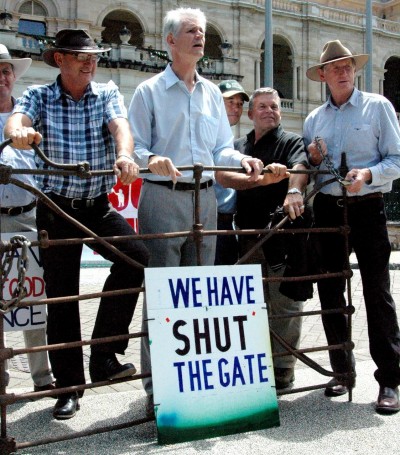It’s full ahead for natural gas, but speed bumps are looming ahead. [26 April 2011 | Peter Boyer]
Between opposing sides in Australia’s climate-energy debate is a twilight zone, inhabited by people who think getting on with their business is more important than resolving the argument.

Farmers and environmentalists join forces in a Brisbane protest against gas exploration on Darling Downs farms.
Here, where all the big decisions about our collective future are being made, hard nuts decide what’s what.
The twilight zone is where the big battles happen, as the top end of town flexes its muscles in defence of capital and growth. The protagonists meet in boardrooms and parliamentary offices — men and women in suits exercising the power that focus and fortune have bestowed on them.
There are no more active players in the twilight zone than Australia’s natural gas industry, and no more focused leaders than Don Voelte, chief executive of Woodside Petroleum, and Belinda Robinson, heading the Petroleum Production and Exploration Association.
Voelte knows better than to argue against cutting carbon emissions. Coal, he says, needs to be replaced, and natural gas is “the saviour — cheap, clean transitional fuel to a better world”.
As Robinson sees it, every tonne of liquefied natural gas (LNG) that China uses instead of coal to generate electricity cuts up to 4.3 tonnes of emissions: “There is no point in constraining the very industry that is the key to assisting the world move to a cleaner energy burning future.”
Then there are the politicians. On the government side, resources and energy minister Martin Ferguson says that with the world entering “the LNG Age” and Australia set to be one of the biggest suppliers by 2015, the industry deserves special treatment under the proposed carbon tax.
His Coalition shadow, Ian Macfarlane, goes several steps further. He considers the carbon tax a waste of effort. Instead, the Coalition is looking at a mandatory target for gas-fired power, doubling its current level to around 40 per cent of national energy generation by 2020.
Even the Australian Greens, though they argue against tax exemption for natural gas, accept its value as a transitional energy fuel.
Natural gas is now a $90 billion industry in Australia, and it’s set to double its size in a few years. Shale gas is the target in South Australia, Western Australia and the Arafura Sea, while there’s a rush on for coal seam gas (CSG) over vast areas of eastern Australia.
It’s all happening because political and business interests everywhere, in lock-step, see natural gas as a low-emission solution on the road to fully sustainable energy.
It looks like a lay-down misere. Coal has to go, but hey, we have plenty of “clean, green” natural gas to replace it. “Gas is King” is the song everyone’s singing, from the same song-book.
But more than a few dud notes are starting to crop up, though the suits may not yet hear them. First, the frantic rush for coal seam gas has mining teams intruding on to productive farmlands, and what they’re doing there is turning many farmers into enraged activists.
The current front line in the farming vs. gas war is in the Darling Downs, where with the open encouragement of the Queensland government a British-owned company, Queensland Gas Company, has drilled thousands of wells — a number expected to increase ten-fold within a few years.
Landowners have discovered the limits to their rights. The law says they can’t refuse entry to these interlopers, who can build roads, install drilling rigs, lay pipes and dig waste water ponds pretty much as they wish. Some farmers are becoming strangers on what they thought was their own land.
Another problem: gas-drilling requires copious amounts of water for fracturing of rock formations, a process called “fracking”. Farmers have noticed the level of their artesian water suddenly plummeting — one estimate had the drilling taking two-thirds of the underground supply.
Worse, fracking is affecting the rock structures that enclose the world’s largest underground aquifer, the Great Artesian Basin, damage that natural processes may take centuries to repair.
Other concerns include the potential for toxic chemicals to enter the water table (benzene and toluene, used in the fracking process, are both hazardous to human health), and the apparent failure of drillers to prevent escape of methane, a powerful greenhouse agent. This last problem has been exercising the mind of Professor Robert Howarth of Cornell University, New York.
In a research letter published last month in the journal Climate Change, Howarth and co-authors Renee Santoro and Anthony Ingraffea give some substance to a long-held concern that far from being a low carbon emitter, natural gas from shale deposits may be little better than what it replaces. According to Howarth and his team, it may even be worse than black coal.
The paper argues that earlier estimates of natural gas emissions underestimate the extent of “fugitive emissions” — gas escaping into the atmosphere — and don’t take account of the powerful short-term warming effect of methane, the main component of natural gas.
The paper’s authors concede that their analysis needs further work. But if they’re right, giving natural gas the big green light has been a costly mistake, and we will need governments to admit the error and turn the policy juggernaut around.
Fat chance, did I hear someone say? In that case, we’re all victims.
